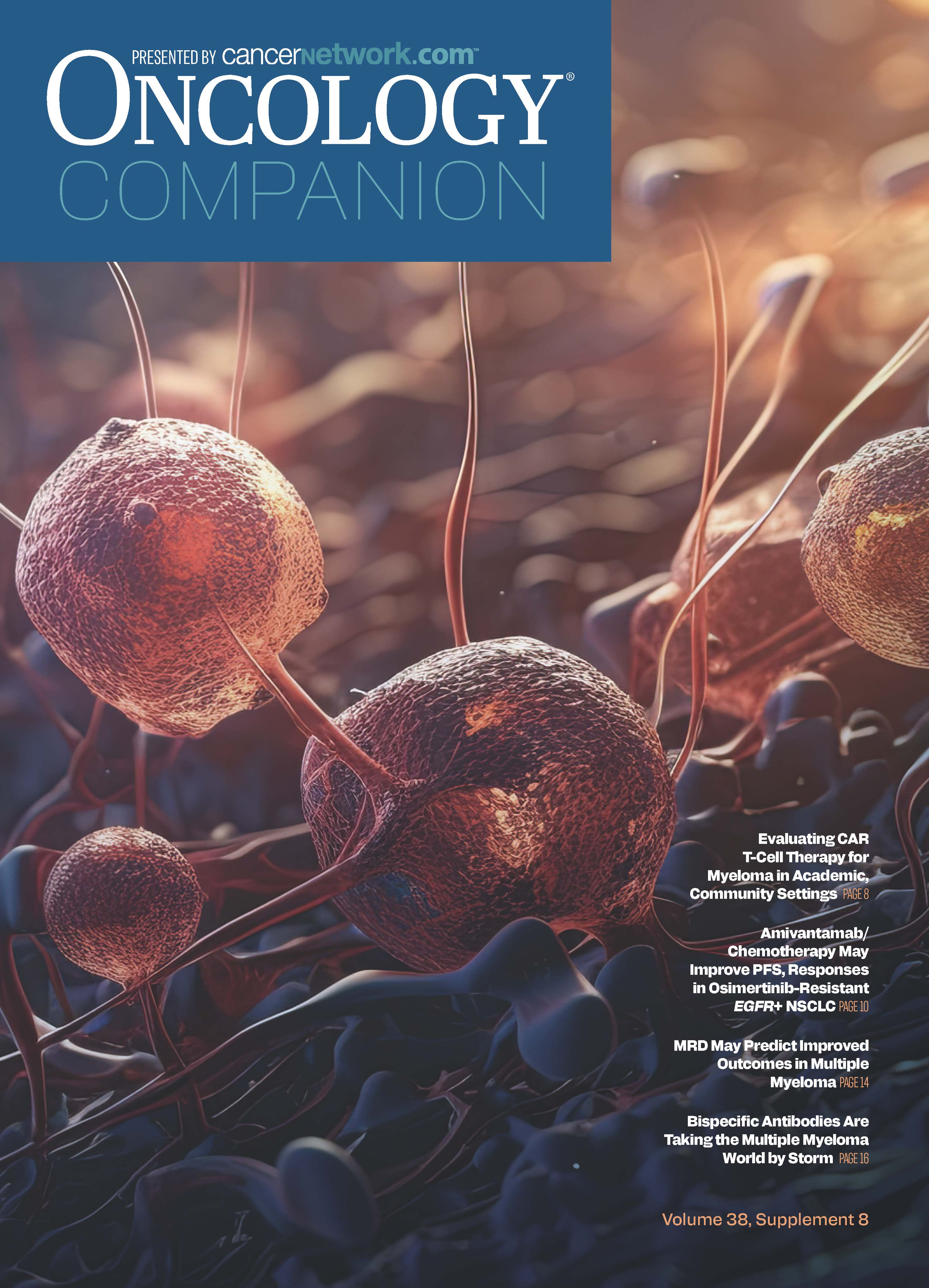Amivantamab/Chemotherapy May Improve Outcomes in Osimertinib- Resistant EGFR-Mutated NSCLC
Findings from the phase 3 MARIPOSA-2 trial were the subject of a recent discussion of ambivantamab plus chemotherapy with or without lazertinib in EGFR-mutated NSCLC.
The expert panel.

In a recent Between the Lines program, Martin F. Dietrich, MD, PhD; Ticiana Leal, MD; and Sandip P. Patel, MD, spoke about the potential implications of findings from the phase 3 MARIPOSA-2 trial (NCT04988295) assessing treatment with amivantamab-vmjw (Rybrevant) plus chemotherapy with or without lazertinib (Leclaza) in patients with EGFR-mutated non–small cell lung cancer (NSCLC) following disease progression on osimertinib (Tagrisso).1
Dietrich is a medical oncologist with The US Oncology Network and an assistant professor of internal medicine at the University of Central Florida in Orlando. Leal is an associate professor and director of the Thoracic Medical Oncology Program in the Department of Hematology and Medical Oncology at Emory University School of Medicine Winship Cancer Institute in Atlanta, Georgia. Patel is a professor of medicine at University of California San Diego Health.
Beyond the key efficacy and safety data reported in the MARIPOSA-2 trial, the group discussed how these findings may affect the standard of care and address unmet needs among patients who experience resistance to prior therapy with osimertinib. Looking ahead, these experts also reviewed any potential unanswered questions from the trial, including those on overcoming osimertinib resistance in EGFR-mutated NSCLC.
Osimertinib Limitations in NSCLC
Dietrich first contextualized the MARIPOSA-2 findings by outlining the limitations associated with osimertinib as a treatment of advanced NSCLC. Although the agent is a frontline standard-of-care option for disease harboring EGFR mutations, resistance to the agent may develop through acquired EGFR or MET alterations. Moreover, poor outcomes with platinum-containing chemotherapy following progression on osimertinib necessitated the development of alternative treatment strategies in this setting.
Investigators of early phase 1 studies hypothesized that combining amivantamab, an EGFR-MET bispecific antibody active against various resistance mutations, with chemotherapy could address these osimertinib resistance mechanisms while improving outcomes compared with chemotherapy alone. As investigators proceeded to assess this combination, questions remained regarding the frequency of disease developing osimertinib resistance in the frontline setting and how amivantamab may address the needs of patients with such resistance.
“Osimertinib has met a huge clinical need for our patients with EGFR mutations in the frontline setting. However, resistance is a part of the disease course, and it does happen within 18 months after initiation of osimertinib,” Leal said.
“The MARIPOSA-2 data fill a gap there for patients with osimertinib resistance. The challenge of [determining] which patients need the addition of amivantamab is still an unanswered question.”
The MARIPOSA-2 Trial Design and Population
Investigators of the international MARIPOSA-2 trial randomly assigned 657 patients with locally advanced or metastatic EGFR-mutated NSCLC 2:2:1 to receive amivantamab plus chemotherapy (n = 131), amivantamab/lazertinib plus chemotherapy (n = 263), or chemotherapy alone (n = 263). Patients received amivantamab at 1400 mg for the first 4 weeks followed by 1750 mg every 3 weeks beginning at cycle 3. Investigators administered lazertinib at 240 mg once daily following carboplatin. Chemotherapy consisted of carboplatin with area under the curve value of 5 for the first 4 cycles plus pemetrexed at 500 mg/m2 until progressive disease. Specifically, the MARIPOSA-2 trial included patients with exon 19 deletions or L858R mutations.
The trial’s primary end point was progression-free survival (PFS), with secondary end points including objective response rate (ORR), duration of response (DOR), overall survival, PFS after the first subsequent treatment, and safety. Those with disease progression on or following osimertinib monotherapy and with brain metastases that were clinically stable, asymptomatic, or managed with steroids were eligible for enrollment in the trial.
Of note, Dietrich highlighted the performance statuses of the patients as a distinguishing feature in terms of baseline characteristics. In the chemotherapy, amivantamab/chemotherapy, and amivantamab/lazertinib plus chemotherapy arms, 62%, 58%, and 65% of patients, respectively had an ECOG performance status of 1. According to Dietrich, it is not uncommon to see some degree of clinical decline in patients following progression on frontline therapy.
Efficacy and Safety Results
The median PFS in the chemotherapy, amivantamab/chemotherapy, and amivantamab/lazertinib plus chemotherapy arms was 4.2 months (95% CI, 4.0-4.4), 6.3 months (95% CI, 5.6-8.4), and 8.3 months (95% CI, 6.8-9.1), respectively. At 12 months, the PFS rates in each arm were 13% (95% CI, 8%-20%), 22% (95% CI, 12%-34%), and 37% (95% CI, 29%-45%).
Data also highlighted an ORR of 36% (95% CI, 30%-42%) with chemotherapy, 64% (95% CI, 55%-72%) with amivantamab plus chemotherapy, and 63% (95% CI, 57%-69%) with amivantamab/lazertinib plus chemotherapy. The median DOR in each respective arm was 5.6 months (95% CI, 4.2-9.6), 6.9 months (95% CI, 5.5-not evaluable [NE]), and 9.4 months (95% CI, 6.9-NE).
Study treatment also yielded a median intracranial PFS of 8.3 months (95% CI, 7.3-11.3) in the chemotherapy arm, 12.5 months (95% CI, 10.8-NE) in the amivantamab/chemotherapy arm, and 12.8 months (95% CI, 11.1-14.3) in the amivantamab/lazertinib plus chemotherapy arm. At 12 months, intracranial PFS occurred in 34% (95% CI, 23%-45%), 50% (95% CI, 35%-64%), and 54% (95% CI, 45%-63%) of each respective arm.
Any-grade adverse effects (AEs) affected 93% of patients in the chemotherapy arm, 100% in the amivantamab/chemotherapy arm, and 100% in the amivantamab/lazertinib plus chemotherapy arm. Additionally, grade 3 or higher AEs occurred in 48%, 72%, and 92% of patients, respectively.
In the chemotherapy, amivantamab/chemotherapy, and amivantamab/lazertinib plus chemotherapy arms, respectively, any-grade toxicities that appeared to be associated with chemotherapy included thrombocytopenia (30% vs 44% vs 60%), anemia (40% vs 39% vs 54%), and leukopenia (28% vs 28% vs 40%). Other AEs of special interest in each arm included rash (12% vs 71% vs 75%), venous thromboembolism (VTE; 5% vs 10% vs 22%), and interstitial lung disease (0% vs 2% vs 3%).
“One thing that stood out about the [amivantamab/lazertinib/chemotherapy combination] is that lazertinib, as a targeted therapy, didn’t look as targeted in combination with chemotherapy and amivantamab. There were some toxicities, including thrombosis, that were of concern,” Patel said regarding these findings. “We may not need that small molecule at the time of resistance for central nervous system [CNS] control as long as we have an effective biologic therapy that’s controlling systemic burden [and] preventing CNS seeding. Here, chemotherapy plus amivantamab stood out as the best balance of benefit and toxicity. [There was] a surprisingly positive benefit in the CNS that I did not expect from a large molecule.”
Although protocols mandate that practices employ prophylactic measures to help prevent VTE in patients who receive the amivantamab/lazertinib plus chemotherapy combination, the role of prophylaxis may be more open for discussion when the regimen consists of only amivantamab/chemotherapy. According to Patel, patients who receive amivantamab plus chemotherapy may be eligible to receive prophylactic anticoagulation if they have a high Khorana risk score for VTE.
Considering Clinical Implications and Unanswered Questions
Overall, data from MARIPOSA-2 showed that both amivantamab-based combinations significantly improved PFS compared with chemotherapy alone. Additionally, these combinations conferred higher and longer rates of response while prolonging intracranial PFS. The safety profile of the amivantamab and chemotherapy combination was comparable with prior reports of each individual agent. Additionally, adding lazertinib resulted in more frequent hematological toxicity, necessitating treatment schedule modifications.
Given that patients with EGFR-mutated disease may be at high risk for intracranial progression or relapse in the second-line setting and beyond, Leal emphasized the potential intracranial PFS benefit of the amivantamab-based combination. At the same time, she discussed the importance of maintaining patient quality of life while being proactive in managing AEs that may occur during treatment.
“As patients are benefiting from this therapy, we want to make sure that they are also having quality of life. If [they are] living longer, we hope they’re living better,” Leal said.
As part of applying these results to clinical practice, Patel described the need to conduct appropriate molecular testing via liquid or tissue biopsy to ensure that practices properly match patients with suitable therapies based on their EGFR mutation status. For example, he highlighted the use of a similar regimen as part of the phase 3 PAPILLON trial (NCT04538664), in which patients with exon 20 insertion mutations received amivantamab plus chemotherapy in the frontline setting.2 Performing comprehensive molecular testing to differentiate between exon 19 and exon 20 insertion mutations may help determine a more suitable timing for administering amivantamab-based therapy to patients.
According to the National Comprehensive Cancer Network guidelines for NSCLC, amivantamab plus carboplatin and pemetrexed is a preferred treatment option for patients with EGFR exon 19 deletions or L858R exon 21 mutations following progression on osimertinib.3 The guidelines also highlight that amivantamab plus carboplatin and pemetrexed is a preferred frontline therapy option in patients with EGFR exon 20 insertion mutations.
According to Dietrich, the results of MARIPOSA-2 pose some outstanding questions, including those related to the value of biomarkers in the second-line setting. Biomarker testing has yet to elucidate the specific resistance mechanisms to osimertinib in patients with EGFR-mutated NSCLC. Additionally, the mechanism of action for amivantamab, specifically its potential for CNS activity, is not yet fully defined.
“The intracranial PFS [with amivantamab] was a surprising finding given that we didn’t have a background of activity of amivantamab in the brain. One thought is with a greater extracranial response, you would see improvement in intracranial PFS, but these patients could have had or not had radiation, so it’s going to be important to also understand what those subgroups look like,” Leal said. “The mechanism of why amivantamab has activity in the brain is still unclear. With the mechanism of action, you wouldn’t think that it crosses the blood-brain barrier, and I don’t think we have any preclinical data supporting that.”
References
- Passaro A, Wang J, Wang Y, et al. Amivantamab plus chemotherapy with and without lazertinib in EGFR-mutant advanced NSCLC after disease progression on osimertinib: primary results from the phase III MARIPOSA-2 study. Ann Oncol. 2024;35(1):77-90.
doi:10.1016/j.annonc.2023.10.117 - Zhou C, Tang KJ, Cho BC, et al. Amivantamab plus chemotherapy in NSCLC with EGFR exon 20 insertions. N Engl J Med.2023;389(22):2039-2051. doi:10.1056/NEJMoa2306441
- NCCN. Clinical Practice Guidelines in Oncology. Non-small cell lung cancer, version 7.2024. Accessed July 15, 2024. https://tinyurl.com/yauz45wm

Newsletter
Stay up to date on recent advances in the multidisciplinary approach to cancer.